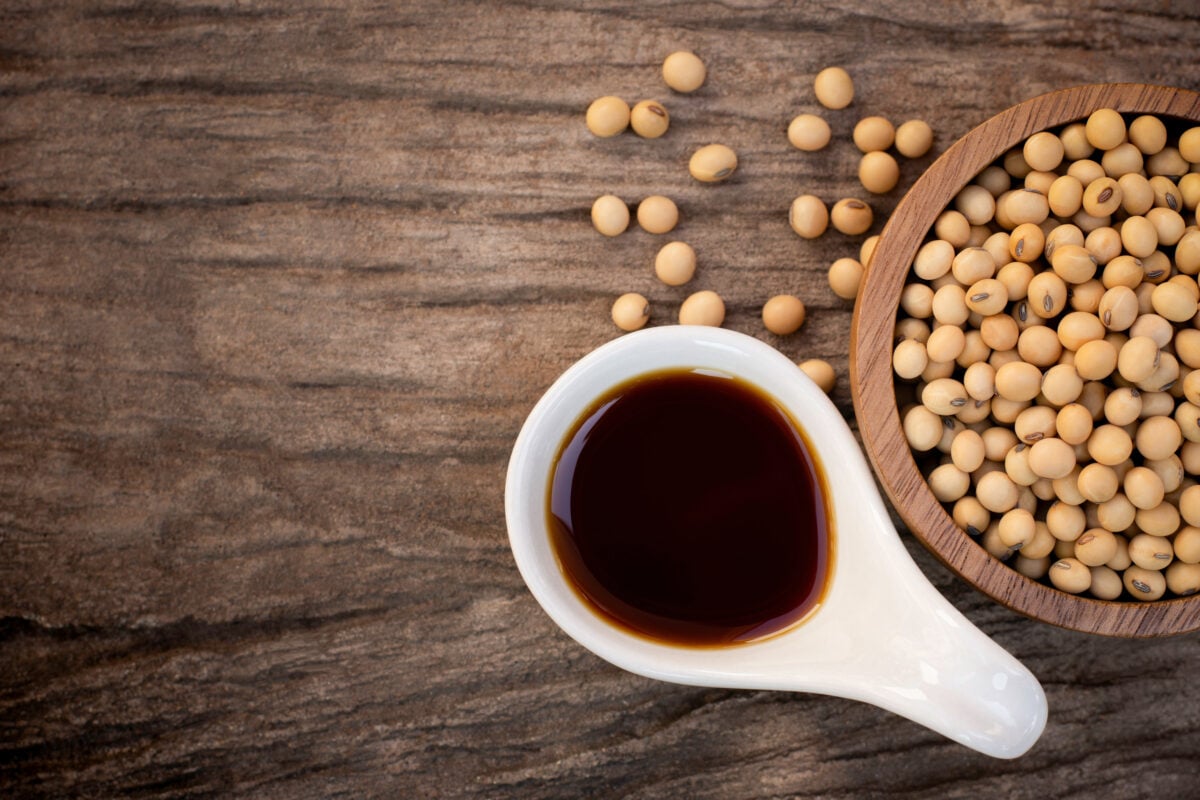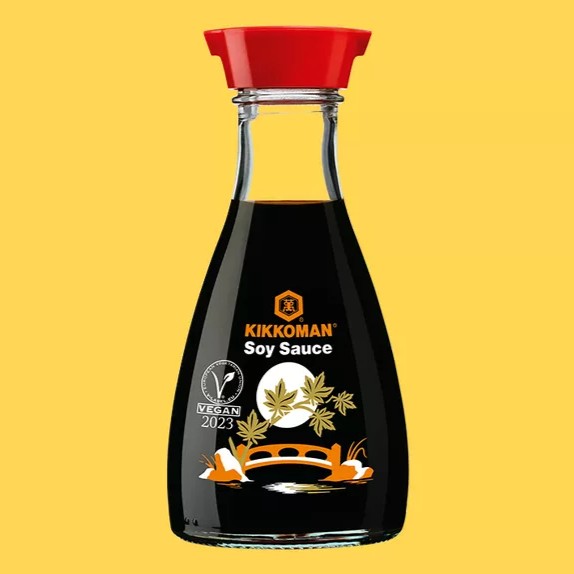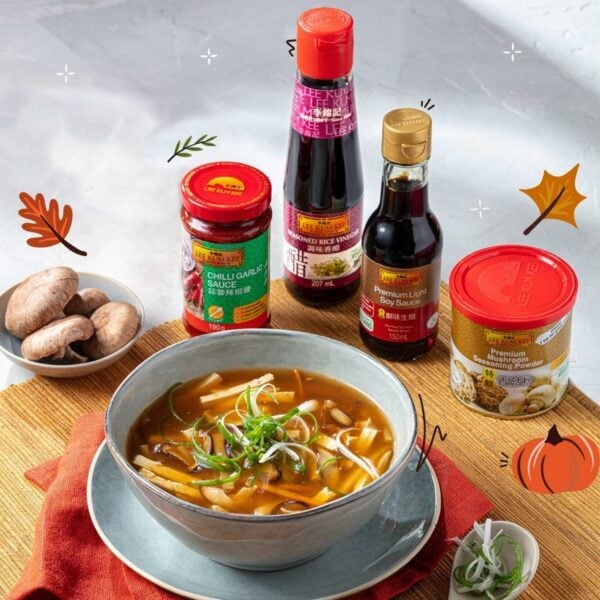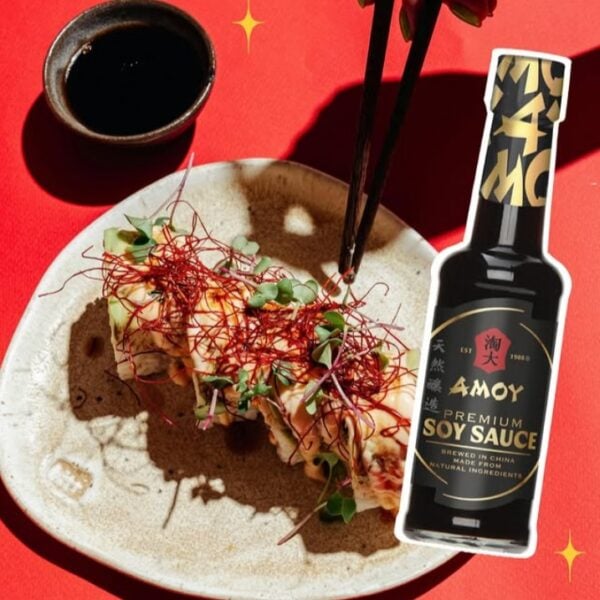Soy sauce is a rich, dark, liquid condiment made from fermented soybeans. It’s versatile, popular, and has been linked to several potential health benefits. But is soy sauce vegan? Here’s everything you need to know about this ancient seasoning.
Soy sauce has a salty, umami flavor and a fruity, alcoholic aroma. It holds an important place in East and Southeast Asian culinary history and has a growing international consumer base that values its flavor, versatility, and other unique qualities.
Traditional soy sauce is made by fermenting soybeans with wheat, salt, and water. While it originates in Ancient China, it quickly became a culturally significant ingredient in Korean, Malaysian, Indonesian, and Japanese cuisines, in particular.
Soy sauce remains the single most popular condiment in Japan, where varieties tend to have a slightly sweet underlying flavor. Soy sauce is one of Japan’s “five core seasonings,” and despite falling national consumption, the average Japanese citizen consumed six litres in 2018.
The Asia-Pacific region still dominates the soy sauce market, but international consumer interest has grown considerably. According to Spherical Insights, the global market was valued at USD $48.1 billion in 2022, and is expected to reach $83.8 billion by 2032.
Particular growth is expected in North America over the coming years, and 65 percent of American households now keep soy sauce in their pantry. Around 2.21 million Americans reported consuming four or more bottles, cans, or jars of soy sauce in 2020.

In China and Japan, soy sauce originated as a combination of salt with fish or meat paste, but the animal-derived ingredients were eventually replaced entirely with soy beans. This veganizing process is notably linked to Buddhist monks, who promoted vegetarianism and many of the other soy-based foods – such as tofu or miso – that later became key parts of the region’s various national cuisines.
Traditionally, soy sauce includes just the four core ingredients – soybeans, salt, wheat, and water – making it suitable for vegans. While there are a variety of different ways of making soy sauce, the majority use plant-based ingredients and processes.
While many varieties of soy sauce are still fermented in the traditional way, some modern, commercial versions are produced using chemical hydrolysis, and may include additional ingredients for coloring, flavor, texture, and to extend the seasoning’s overall shelf life.
Some varieties – particularly the cheaper, mass-produced, hydrolyzed kind – can be particularly vulnerable to cross-contamination, and might also include non-vegan additives. For example, common flavor enhancers such as disodium inosinate can be derived either from fermented plant-based ingredients or extracted from meat and fish products.
Specialty flavors may also combine soy sauce with fish sauce, or other animal-derived seasoning, within the same product. As always, it’s worth checking the ingredients on any item before you buy it, either manually – referencing something like Vegan Easy’s food additives list – or with an automatic platform like Double Check Vegan. (Check out some useful fish sauce substitutes here.)
Most varieties of soy sauce are high in salt, which means they are typically high in sodium, and this means that people who are attempting to lower their intake should consume soy sauce mindfully. However, since soy sauce is far lower in sodium than a typical table salt, it can also make a useful substitute seasoning for folks who are looking for flavorful alternatives.
Sodium is an essential nutrient that supports healthy nerves, muscles, cells, and plasma. Humans cannot survive without consuming sodium, and following a diet with too little can be extremely harmful. However, a deficiency is fairly unlikely for most healthy people.
In contrast, many people consume too much sodium, which can also be very harmful. On average, Americans consume over 3,300 mg of sodium per day, which is far higher than the American Heart Association’s “ideal limit” of 1,500 mg and its upper limit of 2,300 mg.
According to Healthline, one tablespoon of soy sauce contributes 38 percent of the current RDA for sodium, while the same amount of salt contributes nearly 300 percent. Soy sauce comes with other potential benefits, too, particularly when brewed naturally using fermentation.
Soy sauce consumption has been linked to a healthy gut and immune system, while certain fermented, low-salt varieties may support a reduction in blood pressure. It may also aid digestion, provide a source of antioxidants, and have certain anticancer properties. However, existing human studies are too small to indicate how healthful soy sauce is in a typical diet.

When trying to find the best vegan soy sauce, it’s worth trying different varieties to compare flavors, nutrient density, and other factors, depending on the dish, recipe, or profile you have in mind. The major overarching categories for soy sauce include light, dark, double fermented, sweet, and tamari, the latter of which is often gluten-free.
Several of the widely available tamari brands in the UK are also organic, and tamari features a darker color and thicker consistency than other varieties of soy sauce. Tamari has been described as the “original” Japanese soy sauce, or shōyu, and is primarily produced in the Chūbu region. Important note: Some tamari contains reduced wheat rather than no wheat.
Double-fermented varieties typically have a stronger and more umami-focused flavor than others, making them ideal for dipping sauces. They are sometimes made by substituting light soy sauce from a previous batch in place of water and salt, creating additional complexity.
Sweet soy sauce is Indonesian in origin, and combines traditional ingredients with palm sugar or jaggery, along with spices such as cinnamon, coriander, and star anise. The result is a black, syrupy, sweet-and-salty sauce ideal for dipping, drizzling over fried tofu, or making satay with.
Adding sugar or molasses can also aid the production of dark soy sauce, as can double-fermentation, or simply a longer ageing period. Dark soy sauce is thicker with a slightly sweet undertone, while light varieties are thinner, with a salty, aromatic final product.
You can find soy sauce almost anywhere in the US and the UK, from major supermarkets and grocery chains to specialist food stores and online retailers. Chains such as Sainsbury’s in the UK and Kroger’s in the US even stock their own private-label versions – albeit with mixed reviews – while international supermarkets can carry dozens of different varieties and flavors.
Here are some of the most common vegan soy sauce brands.

Kikkoman is the world’s largest producer of soy sauce and was founded over 400 years ago in 1603. The Japanese company makes a huge variety of different soy sauces, including organic, gluten-free, and premium versions, as well as its original traditionally-brewed option. Kikkoman sauces come with a slightly higher price tag than private label options without breaking the bank, and are widely available in the US and the UK.

Hong Kong-based Lee Kum Lee makes a huge variety of different sauces and was founded in 1888. It is also one of the most widely available brands, particularly for soy sauces, and the range includes premium light, dark, sweet, oriental, and hot chili flavors. In the UK, Lee Kum Lee is carried by many mainstream and international supermarkets alike.

Clearspring makes several soy sauces, including an organic tamari that the brand describes as “double strength” for a “smoother and more balanced flavour.” The company also produces shōyu soy sauce, organic soy sauce, and other varieties made using traditional fermentation. Clearspring products are available from several digital wholefoods platforms and Ocado.

San-J makes its gluten-free, non-GMO tamari with 100 percent soybeans, which the company says makes for “a noticeably richer and bolder taste” with 30 percent more umami than its competitors. It’s available online in the UK and more widely in the US.

Amoy is one of the more commonplace soy sauce brands in UK supermarkets, and its full range includes light, dark, and “premium” varieties, the latter of which is brewed using traditional fermentation techniques. The brand’s products are available online in the US.









